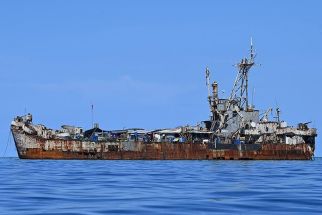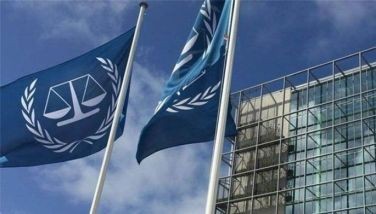Prayers, tears one year after Yolanda
TACLOBAN CITY, Philippines – Survivors of the strongest typhoon ever to hit land wept at mass graves yesterday during ceremonies to mark one year since Super Typhoon Yolanda devastated central Philippines and condemned millions to deeper poverty.
Yolanda (Haiyan) claimed more than 7,350 lives as it swept in off the Pacific Ocean, with its record winds and once-in-a-generation storm surges flattening entire towns.
The monster storm tore across a corridor of Samar and Leyte where about 14 million people lived in farming and fishing communities that were already among the nation’s poorest.
The rebuilding effort has been painfully slow for most survivors, with millions poorer and many dangerously exposed to the next big storm as they still live in shanty homes along coastal areas.
In an outpouring of grief, thousands marched to mass grave sites scattered across the typhoon zone yesterday to
offer flowers, light candles and say prayers.
Josephine Crisostomo, 41, whose three children died during the storm, was among a big crowd at a site on the outskirts of badly hit Tacloban City where more than 2,000 people were buried.
“I miss my children terribly, especially John Dave who would have celebrated his birthday tomorrow... I miss you, son, I love you so much,” Crisostomo said.
Using felt-tip pens, mourners wrote names of those who died on the hundreds of white crosses planted on parched earth in symbolic gestures as many of those buried there had not been identified.
“I am looking for my brother, but his name is not on the list of those buried here,” said 50-year-old Elena Olendan, her eyes welling with tears, as she wandered around the gravesite, about the size of six basketball courts.
Olendan then found a cross at the far end of the mass grave and wrote her brother’s name, Antonio, on it.
At the Tacloban gravesite, white doves and balloons were released after Bishop John Du led prayers at the site where close to 2,300 people are buried.
At a city hall commemoration, 1,000 white balloons were released to signify acceptance of the human loss.
Tacloban City Mayor Alfred Romualdez, who attended the ceremony, said yesterday’s solemn rites gave the survivors an opportunity to let emotions come out.
“It’s bittersweet because while they survived, they lost their loved ones, their livelihood and their homes. Now is really the time for them to grieve,” Romualdez said.
‘On the road to recovery’
And while millions are enduring Yolanda-exacerbated poverty, there has been some remarkable progress from a year ago, partly due to international aid agencies pumping hundreds of millions of dollars into the region.
Some of the big successes of the campaign have been the restoration of electricity within a few months, quick replanting of rice crops and sanitation programs that prevented major outbreaks of killer diseases.
A year after the tragedy, the United Nations declared the Philippines to be “well on the road to recovery” as efforts to rebuild the livelihoods of local communities begin to yield results.
The UN agencies, however, also observed that much work remained to be done in assisting those still afflicted by displacement and lost employment opportunities.
On Friday, the eve marking the first year after Yolanda, UN Food and Agriculture Organization (FAO) director general Jose Graziano da Silva declared that farmers are the backbone of this recovery and the key to build community resilience to future disasters.
“Their work now will ensure that when the next typhoon hits, the impacts are smaller and they are able to recover quicker,” Da Silva said.
Yolanda left an estimated $12 billion in damages in the agricultural sector.
Within hours after Yolanda made landfall, 1.1 million tons of crops suffered severe damage.
Coconut farmers, for instance, lost some 44 million trees to the storm, dealing a debilitating blow to their livelihoods. Coconut trees take six to eight years to become productive again.
At the same time, nearly two-thirds of fishing communities lost their productive assets.
“Farmers have been key responders in this emergency. We helped them source seed to plant in time. They, in turn, filled local markets with rice four months later,” said Jose Luis Fernandez, FAO representative to the Philippines.
“Without their perseverance, food aid and other forms of humanitarian assistance would have been required much longer and for many more people,” he added.
Leveraging nearly $40 million in support from the international community, FAO and local authorities have funneled assistance to 150,000 farming and fishing families or some 750,000 people in four critical areas of intervention: rice and corn farming, fisheries and coastal communities, coconut-based farming systems and coastal/mangrove forest rehabilitation.
“With one-third of the country relying on the agriculture sector for their livelihood, it is crucial to get people back on their feet as quickly as possible and assist them in rebuilding their lives,” Fernandez said.
In a briefing yesterday from Geneva, the UN humanitarian agencies also underscored the gains made by the Philippines a year after the tragedy.
Julie Hall of the World Health Organization explained that, from a health perspective, the past year had been very challenging for the Philippines, which had lost 600 health facilities in the storm.
Hall said the international community’s response had been overwhelming as aid poured in to the affected areas and around half of the damaged facilities had been repaired or were in the process of reparation.
Hall, however, noted that levels of functionality between health centers varied, medicine was running out and a recent uptick in mental health issues could be observed.
Meanwhile, the Office for the Coordination of Humanitarian Affairs spokesperson Jens Laerke said the UN humanitarian wing had served roughly 3.7 million people with food assistance, almost one million with rehabilitated water systems and established 4,900 temporary learning spaces for children.
He said that OCHA had been humbled by the extraordinary resilience of the Filipino people who had pushed through the disaster and towards recovery individually and collectively.
For its part, the UN refugee agency UNHCR said it was now focusing on the remaining 20,000 people still living in 56 displacement sites across typhoon-affected areas after the majority of the 4.1 million displaced persons had returned home to rebuild or been relocated.
As UNHCR worked to provide those still displaced with shelter, water and sanitation, spokesman Adrian Edwards said the agency was also lobbying for the government to adopt legislation protecting the rights of displaced people.
He said the passage of such legislation would be very timely as the country welcomes crucial steps in attaining sustainable peace in the southern Philippines.
The UN Resident and Humanitarian Coordinator in the Philippines on behalf of the Humanitarian Country Team to mark the anniversary remembered all those who lost their lives and acknowledged the extraordinary resilience of the Filipino people.
“We are privileged to have been able to contribute to the humanitarian response led by the government of the Philippines and will continue to support recovery efforts at all levels and in particular through the Office of the Presidential Assistant for Rehabilitation and Recovery and relevant line ministries,” said Luiza Carvalho, Resident and Humanitarian Coordinator in the Philippines.
The build-up to the anniversary had focused renewed attention on the pace of the reconstruction effort, with President Aquino criticized by many for a perceived lack of urgency.
Roughly one million people need to be moved away from coastal areas that are deemed vulnerable to storm surges, according to a P3.6-billion government master plan for rebuilding the typhoon zones.
However, those plans have already fallen behind schedule, delayed by problems in finding new land that is safe and suitable for 205,000 new homes.
Across the typhoon-hit islands, schools, health centers, gymnasiums and other important community buildings are also yet to be rebuilt or repaired.
In a speech at the typhoon-hit town of Guiuan on Friday, President Aquino defended the pace of the reconstruction and recovery program, saying he was determined to ensure it was carried out correctly rather than rushing the reconstruction work.
“Curse me, criticize me but I believe I must do the right thing,” Aquino said.
“I am impatient like everyone else but I have to stress that we can’t rebuild haphazardly. We have to build back better... let’s get it right the first time and the benefits should be permanent.”
Challenges
While the exact figures for the dead and missing are still being collected, the physical recovery remains a challenge. The typhoon demolished about a million houses and displaced more than four million people in the region.
Overall damage was estimated at P571.1 billion, including about 16 million knocked-down coconut trees, a major source of livelihood.
With the loss of income, about a million more people were pushed deeper into poverty, according to the Asian Development Bank.
Building more than 200,000 new houses for the poor, who were left with nothing, is proving difficult.
The government, backed by international donors, has built temporary bunkhouses and shelters, but many residents have hammered back their shacks in the same coastal villages where they were hit by the storm – and which have been officially declared “no-build zones.”
About 3,000 people still live in tents in Tacloban, though the city government has pledged to move them to permanent housing by the end of the year.
Under the long-term plan to protect against similar typhoon onslaughts, the government wants to build an elevated road connecting Tacloban to two coastal towns that will also serve as a dike.
“Like you, I am impatient,” President Aquino told residents of Guiuan, the first town that was literally hammered down by Yolanda. “We can’t be reckless as we build back better.”
Just like the town of Guiuan, Tacloban was the worst hit by the storm and the other outlying regions have crawled back from the rubble. Shopping malls, hotels and offices have reopened, with cars, taxis and motorcycles clogging downtown streets – the same spots where huge mounds of debris and bodies lay scattered weeks after Yolanda blew away. Yet, human scars are harder to overcome.
Four months after she lost her husband and home to Yolanda’s fury, Agnes Bacsal gave birth to their sixth child – a sprightly boy, whose company has eased the family’s pain.
Other survivors, like fisherman Ben Pedrero, still struggle. His wife and son perished in the monster storm and more than 40 other relatives are still missing.
“In just a blink of an eye, they were all gone,” the 61-year-old Pedrero said.
“I’ll only overcome this tragedy when I die myself,” he added, wiping tears with his shirt as he helped relatives roast a pig and prepare food for yesterday’s anniversary.
The seven-meter high waves also took away Pedrero’s house with all its precious belongings – his family’s pictures and personal mementos. Also gone was his fishing boat, his only source of income.
Like him, Bacsal still relies on dole-outs mostly from relatives and friends. Without her husband, tricycle driver Jonathan, and her house, she now lives with her six children in a shack built from storm debris.
Amid continuing adversity, Bacsal’s family is being held together by faith – an altar with rosaries and the images of Jesus Christ and the Virgin Mary adorn a wall – and a bubbly, new family member, 7-month-old baby John William. His cries filled the bare shack.
“He gives me joy, just by being beside me,” Bacsal said, cradling her baby.
A 14-year-old daughter, Maria Jean, beamed with optimism. “I’ll be the best businesswoman in Asia and bring them out of here someday,” she said when asked about her plans.
With help from relatives and friends, Bacsal was able to send Maria Jean to high school. They scrimp on grocery items recently donated by a city official and were able to sell extra foodstuff to neighbors in a sari-sari store.
Jun Janedo, 32, also owns a store selling local delicacies to visitors as his means of livelihood. He used to live in the coastal area of Tacloban.
Although he lost his house and everything in it, Janedo was fortunate to account for his wife and three children alive after the storm surge brought about by the typhoon.
“A day before Yolanda struck, we evacuated to safer ground. But we lost our house and everything inside,” Janedo said.
Interior and Local Government Secretary Manuel Roxas II said local businesses would restore normalcy in the economy in the region and the delivery of basic commodities will be stable again once the public markets are rehabilitated.
“With the completion of the local government buildings, the municipal employees can work effectively and give more efficient services to their constituents,” Roxas explained.
Roxas assured the affected towns that the national government is ready to assist them as they rebuild their lives and be accustomed to disaster preparedness measures.
Officials said some P570 million in additional funds is needed for the recovery and rehabilitation of local infrastructures, local bridges, slaughter houses and water facilities in Yolanda stricken areas.
Rolyn Zambales, chief of the Office of the Project Development Service, said rehabilitation of local infrastructure like bridges, slaughter houses and water facilities in Yolanda stricken areas was not included in the initial assessment.
“The construction activities at the 184 more municipal halls, civic centers, public markets are ongoing, 28 others are under procurement,” Zambales said. – With AP
- Latest
- Trending






























